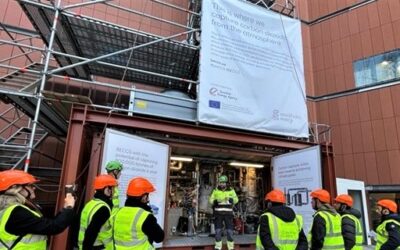On Wednesday, October 18, public and private Swedish and UK stakeholders met at the Swedish Embassy in London to share best practices related to the development and integration of new heat in urban planning.

Sweden and the UK face very different challenges when it comes to developing heat networks. With more than 50% of domestic heating demand supplied by heat networks, Sweden has many older schemes and a growing demand for re-investment. At the same time, low electricity prices limit the profitability of CHP electricity production, and the competition from new technologies, such as heat pumps, grow quickly.
The UK is on the other side of the spectrum with less than 3% of heat supplied by heat networks. However, there is a high ambition to develop new schemes. It gives the UK a unique opportunity to develop a new class of strategic asset that can supply not only residential, but also commercial and industrial customers with affordable, secure, stable low carbon heat for +70 years.
Despite the very different starting points, there are several key topics that will be important to successfully retrofit old schemes, as in the case of Sweden, and when building new schemes, as in the case of the UK. At a recent workshop at the Embassy of Sweden in London, the Swedish Energy Research Centre explored challenges and opportunities linked to the development of heat networks in the UK, drawing from experiences from Sweden. They outlined three solutions that are key to enable a successful development and integration of heat networks.
1. Plan for system-wide integrated solutions (lower costs of heat from heat networks, while accomplishing system energy efficiency)
2. Shift from commodity supplier to energy services
3. Lower the entire distribution temperature (and integrate more excess heat from urban activities)
We would like to thank Fredrik Martinsson from the Swedish Energy Research Centre for joining the workshop in London on Wednesday, October 18th and sharing his expertise. Please find more information about the Energy Research Centre and their current projects at www.energiforsk.se.
More information:
Please contact the Heat Networks team if you wish to learn more about this specific workshop and topic. Participants of the recent workshop included London Borough of Brent, London Borough of Ealing, London Borough of Greenwich, London Borough of Merton, Stoke-on-Trent City Council, Birmingham City Council, Glasgow City Council, Exeter City Council and the Greater London Authority. Swedish ESCOs and suppliers participating included Göteborgs Energi, Borlänge Energi, Öresundskraft, Sweco, FVB and Alfa Laval to mention a few.
Sweden is at the forefront of decentralised heat networks technology. Our aim for “Heat Networks – Sustainability by Sweden” is to facilitate knowledge sharing between British and Swedish stakeholders and develop and encourage environmental and economic best practice.
To find out how we can help you and your organisation, please contact our London-based “Heat Networks” team. We can introduce you to leading consultants, suppliers of technology and services who will be pleased to share know-how of the development of heat network solutions.


